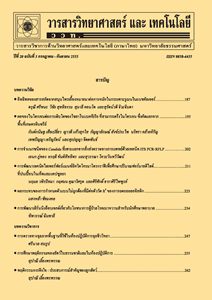การสำรวจติดตามปริมาณสารมลพิษตกค้างยาวนานบางชนิดและสารเคมีกำจัดศัตรูพืชกลุ่มออร์กาโนคลอรีนในเนื้อสัตว์และผลิตภัณฑ์ประมงในประเทศไทย
Main Article Content
Abstract
บทคัดย่อ
จากการที่ประเทศไทยเป็นสมาชิกภายใต้ข้อตกลงระหว่างประเทศในอนุสัญญาสตอกโฮล์มว่าด้วยสารมลพิษที่ตกค้างยาวนาน ตั้งแต่ปี พ.ศ. 2548 ซึ่งอนุสัญญาดังกล่าวมีจุดมุ่งหมายในการจัดการ กำจัด ควบคุม และลดผลกระทบของสารมลพิษที่ตกค้างยาวนาน (persistent organic pollutants, POPs) ต่อสุขอนามัยของมนุษย์และสิ่งแวดล้อม ข้อมูลการสำรวจปริมาณสารมลพิษตกค้างยาวนานจึงมีความสำคัญในการใช้ประเมินความเสี่ยงผลกระทบดังกล่าว ในปี พ.ศ. 2553 สำนักคุณภาพและความปลอดภัยอาหารจึงได้ทำการสำรวจสารมลพิษตกค้างยาวนานที่เป็นสารเคมีกำจัดศัตรูพืช 8 ชนิด ได้แก่ aldrin, chlordane, DDT, dieldrin, endrin, heptachlor, endosulfan และ lindane และสาร non dioxin-like polychlorinated biphenyls (PCBs) 7 ชนิด รวมทั้งสารเคมีกำจัดศัตรูพืชกลุ่มออร์กาโนคลอรีนชนิดอื่นอีก 3 ชนิด ในเนื้อสัตว์ โดยเก็บเนื้อสัตว์ที่คนไทยนิยมนำมาบริโภค ได้แก่ เนื้อสัตว์ปีก เนื้อหมู เนื้อวัว เนื้อสัตว์น้ำและสัตว์ทะเล รวมจำนวน 73 ตัวอย่าง ในตลาดสดจาก 8 จังหวัด ที่เป็นตัวแทนจากทั้ง 4 ภาค ของประเทศไทย ตรวจวิเคราะห์ชนิดและปริมาณสารโดยวิธี modified AOAC official method 970.52 ใช้เครื่องมือ GC-µECD และ GC-MS ผลการตรวจวิเคราะห์ตรวจไม่พบการตกค้างของสาร PCBs 7 ชนิด ในทุกตัวอย่าง (LOD = 0.003 มิลลิกรัมต่อกิโลกรัม) แต่พบการตกค้างของสาร p, p´-DDE ในกลุ่ม DDT ในช่วง 0.008-0.05 มิลลิกรัมต่อกิโลกรัมไขมัน ในตัวอย่างปลาน้ำจืด 3 ตัวอย่าง ซึ่งปริมาณการตรวจพบดังกล่าวต่ำกว่าค่าปริมาณสารพิษตกค้างสูงสุดที่ปนเปื้อนจากสาเหตุที่ไม่อาจหลีกเลี่ยงได้ (extraneous maximum residue limit, EMRL) ที่ 1 มิลลิกรัมต่อกิโลกรัมไขมัน ตามประกาศกระทรวงสาธารณสุข เรื่อง อาหารที่มีสารพิษตกค้าง พ.ศ. 2554 กับตรวจพบสาร endosulfan sulfate ในกลุ่ม endosulfan ปริมาณต่ำ ที่น้อยกว่า 0.005 มิลลิกรัมต่อกิโลกรัมไขมัน ในตัวอย่างปลาน้ำจืด 1 ตัวอย่าง ข้อมูลดังกล่าวแสดงให้เห็นว่าเนื้อสัตว์ที่คนไทยบริโภคและผลิตในประเทศไทยมีความปลอดภัยจากการปนเปื้อนของสารมลพิษตกค้างยาวนาน
คำสำคัญ : สารมลพิษที่ตกค้างยาวนาน; เนื้อสัตว์และผลิตภัณฑ์ประมง; สารกำจัดศัตรูพืชกลุ่มออร์กาโนคลอรีน; สารพีซีบี
Abstract
Since 2005, Thailand has been a signatory of the Stockholm convention on persistent organic pollutants (POPs). The convention aims to manage, eliminate, control and reduce the impact of POPs on human health and environment. Therefore, POPs contamination monitoring data are necessary for the risk assessment process to identify and evaluate their adverse effects. In 2010, the survey program was conducted by Bureau of Quality and Safety of Food for the investigation of POPs including 8 pesticides (aldrin, chlordane, DDT, dieldrin, endrin, heptachlor, endosulfan and lindane) and 7 non dioxin-like polychlorinated biphenyls (PCBs) and also other 3 organochlorine pesticides residues in animal tissue. Seventy-three samples were collected from fresh markets in 8 provinces which were 4 regional parts of Thailand representatives. Various kinds of animal tissue commonly consumed by Thais such as poultry, pork, beef, freshwater fish and marine animals were equally considered as target samples. Those contaminants and residues were determined by modified AOAC official method 970.52 (GC-µECD and GC-MS). It was found that 7 PCBs were not detected in all samples at the limit of detection 0.003 mg/kg. Nevertheless, p, p´-DDE (DDT metabolite) was found in 3 samples of freshwater fishes in the range of 0.008-0.05 mg/kg fat. None of samples exceeded the Extraneous Maximum Residue Limit (EMRL) value (1 mg/kg fat) established by Ministry of Public Health. Moreover, the low level (<0.005 mg/kg fat) of endosulfan sulfate (endosulfan group) was detected in one sample of freshwater fish. The result indicated that animal tissue which was produced and consumed in Thailand was safe from POPs contamination.
Keywords: persistent organic pollutants; meat and fishery; organochlorine pesticides; PCBs


